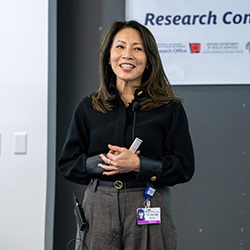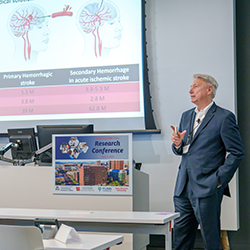Renowned investigators from across Arizona share advances in medical research that may improve patient outcomes
Bringing together more than 190 attendees from around the world — both in-person and online via Whova — the 9th Annual Arizona Biomedical Research Centre (ABRC)-Flinn Research Conference showcased the breakthroughs made by grant awardees from the ABRC, Flinn Foundation and the Valley Research Partnership (VRP).
With 13 oral presentations and 81 research posters on display in the University of Arizona College of Medicine – Phoenix’s Health Sciences Education Building, the conference facilitated important conversations on several critical health topics — including liver fibrosis, innovations in health care education, therapies for intracranial hemorrhage, predicting the risk for Valley fever exposure, better detection of skin lesions and more.
Chris Glembotski, PhD, vice dean of Research, and director of the Translational Cardiovascular Research Center, discussed how this annual event is central to the college’s research mission. “In addition to bringing new information to the college about the methods of clinical research, as well as the future for finding preventative treatments for Alzheimer’s disease, the conference contributed to the college’s research vision of developing strategies for achieving distinction in areas of translational research that link scientific discovery to high priority clinical programs,” he said.
Rosanne M. Kho, MD — chair of the Department of Obstetrics and Gynecology at Banner – University Medical Center Phoenix and the college — as well as Eric Reiman, PhD — professor of Psychiatry at the college and the executive director of Banner Alzheimer’s Institute — were the featured speakers.
Why Engage in Research?
In her presentation, “Value of Clinical Research: Journey from Trials to Development of Practice Guidelines,” Dr. Kho outlined some of the hurdles researchers face as they prepare to take on that challenge, as well as why it is important to participate in clinical research.

For many, those obstacles — time, knowledge of how, access to resources — can seem daunting. But Dr. Kho advised aspiring researchers to focus first on what areas of research interest them most. Once they do, they should familiarize themselves with existing work. “It is so important for us to first know what is already in the literature,” she said. That will allow them to focus on areas that are in the most need of further study.
When physicians engage in research, it will help them to expand their professional network. “For us here in medicine — as surgeons, as clinicians — it is a collaborative team sport. When you are exposed to doing a systematic review, you become the expert in the topic,” she said. “And then you get invited to speak — whether it’s in a national or international forum — which again, allows us to build relationships and friends from all over the world; allows us to identify gaps in literature; and then move the field forward.”
Most crucially, though, Dr. Kho stressed that the practice of medicine depends on evidence. So, if a researcher makes a discovery, it is essential they get it out to the world. “When you engage in research and in trials, it’s so important that you publish — not just a poster, but a research paper — because if you don’t publish, it’s as if your work was never done at all,” Dr. Kho explained.
Preventing Alzheimer’s Disease
Dr. Reiman’s presentation, “Preventing Alzheimer’s Disease Together,” proposed there is a realistic chance for clinicians over the next few years to not only better treat Alzheimer’s disease, but, ultimately, to prevent the onset of it for patients predisposed to the illness.

How is that possible? “We now have definitive clinical trials in paired patients that therapies can reduce amyloid plaque (a cardinal marker of Alzheimer’s) over 18 months and reduce clinical progression (of Alzheimer’s) by 30 percent,” Dr. Reiman said.
“Amyloid plaques have a critical role in the development, potential treatment and potential prevention of Alzheimer’s; and if we have these treatments that are already having that effect — when amyloid plaques have already plateaued and the downstream events have already occurred — imagine what would happen in ongoing prevention trials,” he added.
Despite these promising results, one central issue remains: drug approval. “What we propose is the idea of rather than post-marketing — doing a lot of long, placebo-controlled trials — give everybody access to treatment and use what we’ll call a ‘staggered start design.’ Comparing people who were started earlier to those who are later to show that biomarker effect and that clinical effect over time and confirm the benefit for all of them,” Dr. Reiman said.
By demonstrating those positive outcomes, showing the clinical benefit through data mapping, the hope is to get that approval.
Learn more about two of the funded researchers who presented at this year’s conference:
Guy Reed, MD, MS
Presentation: Targeted Therapy for Intracranial Hemorrhage
Funded By: Flinn Foundation
The research presented by Dr. Reed, a professor of Internal Medicine and the former dean of the college, focused on how to counteract the harmful effects of strokes.

“Stroke really occurs in the form of hemorrhage in two forms, either it is a primary hemorrhage — that’s when a blood vessel ruptures and blood goes into the brain causing deleterious consequences — or it can occur secondary to ischemic stroke,” he said. The potential health outcomes for patients who have suffered a stroke can be dire, often resulting in premature death or disability.
To repel those negative outcomes, Dr. Reed and his fellow researchers used specific inhibitors, in this case monoclonal antibodies, and a control in pre-clinical models to measure the effectiveness of the inhibitors in curbing the effects of the hemorrhage. What they discovered was that the “inhibitor markedly reduces brain hemorrhage,” as well as prevents neuronal cell death and eases brain spotting.
These results suggest that by infusing those specific inhibitors, they will be able to lessen the odds of a patient experiencing disability from stroke.
Soubhagya Nayak, MS
Presentation: Patient-Adaptive Robotic Balance Training for Chronic Stroke Patients
Funded By: ABRC
One out of every four people aged 25 or older is at risk of experiencing a stroke; and 80% of stroke patients experience motor impairments. Currently, the predominant form of recovery for those patients is traditional rehabilitation — repetitive strength exercises with licensed physical therapists.

Through his research, Nayak — a doctoral student in the Neuromuscular Control and Human Robotics Lab at Arizona State University — sought to combine those conventional forms of rehabilitation with existing robotic methods, such as reactive balance boards, to create a more effective method of rehabilitation for stoke patients.
Nayak and his fellow researchers used a dual-axis robotic platform that was connected to a monitor, where they could see how the patient’s balance aligned. The hypothesis was that with, “Real time visual feedback, it will improve the dynamic and function balancing,” he said.
Over the course of six weeks — of pre-assessment, practice, training and post-assessment — they were able to track positive results for those who participated in their study. More promising, in a three month follow up, one patient exhibited that their progress was “not short term,” Nayak said. “They were able to retain some of their improvements.”

